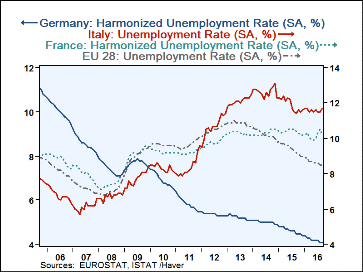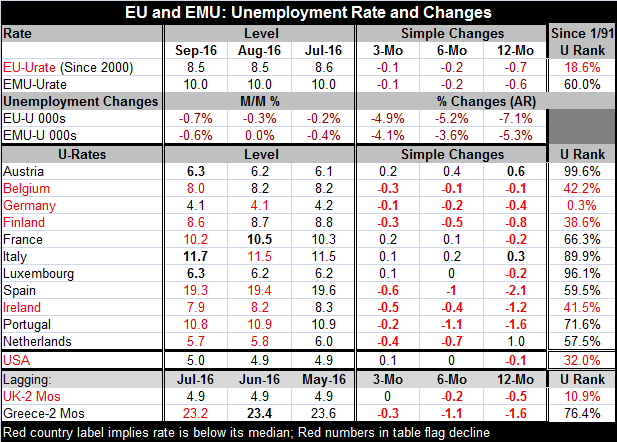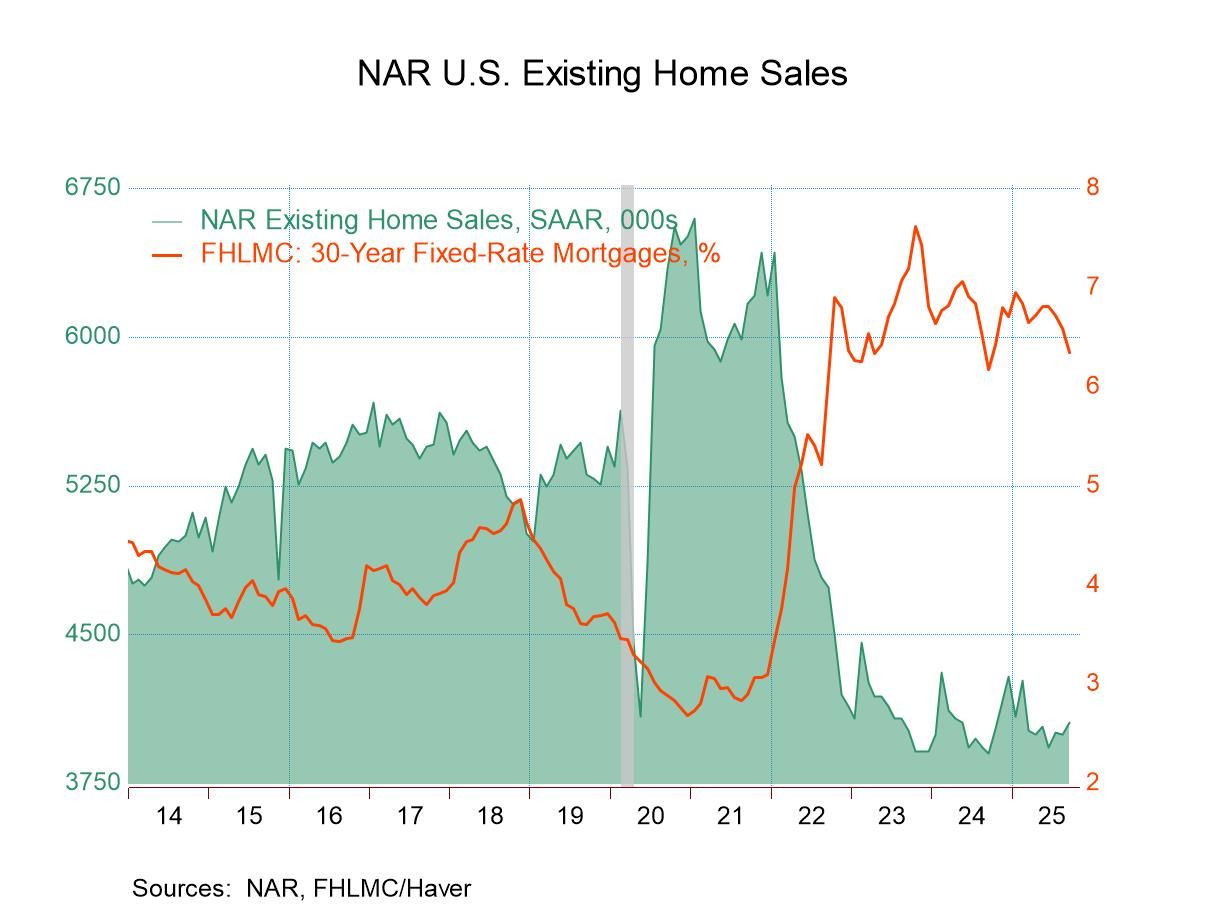 Global| Nov 03 2016
Global| Nov 03 2016Euro Area Unemployment Rate Stays Stuck at 10%, Its All-Time Low
Summary
Unemployment rates in the EMU continue to show more progress than has economic growth. The unemployment rate for all of EU steadied at 8.5% for the second month in a row. The EMU rate stayed at its all-time low of 10% for the third [...]
 Unemployment rates in the EMU continue to show more progress than has economic growth. The unemployment rate for all of EU steadied at 8.5% for the second month in a row. The EMU rate stayed at its all-time low of 10% for the third month running.
Unemployment rates in the EMU continue to show more progress than has economic growth. The unemployment rate for all of EU steadied at 8.5% for the second month in a row. The EMU rate stayed at its all-time low of 10% for the third month running.
Growth rates in the EU and EMU for the number unemployed continue to post negative values as the ranks of the unemployed are being diminished. However, the pace of the ongoing unemployment level shrinkage has slowed with a lesser pace of progress posted over three months and six months than over 12 months.
Among the original EMU members reporting September rates of unemployment, seven of eleven show a further unemployment rate drop in September compared to August. Seven show net unemployment rate drops over three months and over six months while eight show net unemployment rate declines over 12 months.
However, the countries that are not faring as well also notable as two of the largest EMU economies stand among them. In September, Austria, Germany, Italy and Luxembourg showed no rate drop and three of those four (all but Germany) showed an unemployment rate rise. Over three months unemployment rates rose in Austria, France, Italy and Luxembourg. Austria, France and Italy also show net unemployment rate increases over six months with Austria and Italy posting increases over 12 months as well. Two of the euro area's four largest economies, Italy and France, are still struggling to reduce unemployment rates from historically elevated levels.
Despite the ongoing progress, the number for the whole of the euro area looks better than the member by member progress since there is so much unevenness in the EMU. Germany's size and powerful unemployment rate declines have dressed up the overall EU and EMU results. German unemployment is still at a post reunification low. In the EU, the overall area stands in its lower 18th percentile among ranked data of unemployment rates historically. The EMU ranked rate stands only in its 60th percentile. The EU calculation (for now) benefits from the inclusion of the U.K. (where data lag by two months) where the unemployment rate has been lower historically only 10.9% of the time.
EMU results show four of eleven of the earliest EMU members with unemployment rates below their historic medians (Belgium, Germany, Finland and Ireland). The rate for Finland has been lower 38% of the time. Ireland's rate has been lower 41% of the time. Belgium's rate has been lower 42% of the time. Only Germany among EMU members has an extremely low unemployment rate (this low or lower only 0.3% of the time).
However, for much of the euro area unemployment rates are still above their normal rate; unemployment is above its historic median in Austria, France, Italy, Luxembourg, Spain, Portugal, the Netherlands and Greece (with a lag). The unemployment rate is historically still very high in Austria (where it has been higher only 0.4% of the time), in Luxembourg (where it has been higher only about 4% of the time), and in Italy (where it has been higher only about 10% of the time). And still in Greece the rate has been lower about 76% of the time, in France, lower about 66% of the time, in Spain, lower about 59% of the time, and in the Netherlands, lower about 57% of the time.
Europe is making progress on unemployment reduction, but it also has a lot more progress it needs to make. So it's good that unemployment rate progress is ongoing in the EMU, but that by itself is not a victory. Progress is still slow and many countries are still in very difficult times even though they are years removed from the onset of the financial crisis and recession. And now two of the largest EMU countries are struggling to keep that progress in gear. It's correct to say that the euro area is making progress on unemployment reduction; it is also correct to say that the euro area still has a substantial and entrenched unemployment problem.

Robert Brusca
AuthorMore in Author Profile »Robert A. Brusca is Chief Economist of Fact and Opinion Economics, a consulting firm he founded in Manhattan. He has been an economist on Wall Street for over 25 years. He has visited central banking and large institutional clients in over 30 countries in his career as an economist. Mr. Brusca was a Divisional Research Chief at the Federal Reserve Bank of NY (Chief of the International Financial markets Division), a Fed Watcher at Irving Trust and Chief Economist at Nikko Securities International. He is widely quoted and appears in various media. Mr. Brusca holds an MA and Ph.D. in economics from Michigan State University and a BA in Economics from the University of Michigan. His research pursues his strong interests in non aligned policy economics as well as international economics. FAO Economics’ research targets investors to assist them in making better investment decisions in stocks, bonds and in a variety of international assets. The company does not manage money and has no conflicts in giving economic advice.






